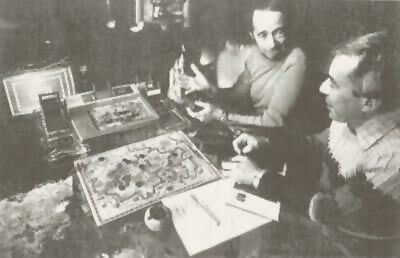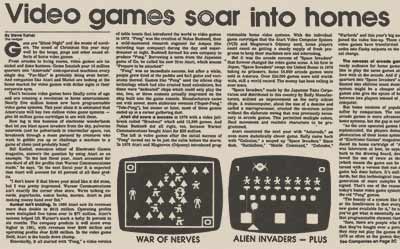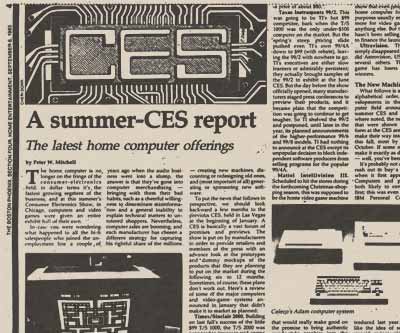ODYSSEY² NEWSPAPER ARTICLES!
The following is a guide to articles with Odyssey² content available in vintage newspapers. Where possible, links to free digital archives are provided.
1981
The UFO Champion of Sights and Sounds '81
What an event! In the early 1980s, The Milwaukee Sentinel put on a photo and stereo show called Sights and Sounds as part of its "Active Americans" community activities program. For the 1981 show, held August 22 and 23, home computers and electronics such as video games were added to the attractions. Imperial Magnavox, a local retailer, provided eight Odyssey² setups to determine the champion UFO player. The highest scorer used the game's ability to display their name on screen, so that future players would know the score they had to beat. The top scorer won an Odyssey² setup with six games. Second prize was "Odyssey equipment" (presumably a console), and third prize was a UFO cartridge. The first 500 players to acheive at least 25 points received a Magnavox t-shirt. The event was free to attend and was held in the Milwaukee Exposition and Convention Center and Arena (MECCA).
In addition to the UFO competition, retailer Video Exchange sponsored an Atari 2600 Space Invaders contest, where scoring at least 5,000 points netted players a Space Invaders t-shirt or other prizes. The event also featured home computers from Apple, Texas Instruments, and Radio Shack; the movie Grease playing on an RCA VideoDisc; and more. About 15,000 people attended. Were you there?
The Milwaukee Sentinel hyped this event in multiple August issues with articles and advertisements, including a post-event writeup on August 24. Unfortunately, no information about the outcome of the UFO contest was included.
1981 Guide to Home Games, by Electronic Games Editors
This guide, by Bill Kunkel and Arnie Katz of Electronic Games magazine, was sydicated to several newspapers by the New York Times News Service. It provides an overview of the programmable consoles available to consumers before Christmas 1981, including the Atari 2600, Odyssey², Intevllision, Astrocade, and Channel F. Katz and Kunkel state that Odyssey² "has struggled to develop a distinctive identity" in the marketplace, but praise the system's recent releases as showing "a firm hand." Between three to five Odyssey² games are reviewed, depending on how much of the original article content appears. The full article covers Baseball (which has "aged well" with "realistic play-action and attractive graphics"), Blockout/Breakdown ("a whimsical variation of the traditional hit-the-bricks game"), UFO (where "the action never stops") and Quest for the Rings (a "sophisticated action/stragegy combination").
Newspapers that printed this article ran it under different headlines, and didn't always include the full content due to space considerations.
Electronic Game Wizards
This article appeared in an Illinois newspaper (title unknown) on November 26, 1981, about one month after the debut of Quest for the Rings. It focuses on Ron Bradford and Steve Lehner, the creators of the Master Strategy Series. Many quotations from Lehner reveal a lot about how the Master Strategy games were conceived and designed. Read it here.
Video bounty expected
A very short overview of home video games available for Christmas 1981 which briefly describes the Atari 2600, Intellivision and Odyssey². The current price of Odyssey² is given as $149, with most games priced at $20 – although the Master Strategy series can cost up to $49. K.C. Munchkin is identified as one of the most popular Odyssey² games.
Video games soar into homes
This piece provides a brief overview of arcade and video game history before describing the relative merits of Atari 2600, Intellivision and Odyssey². Author Steve Turner describes Odyssey² as "a blend of arcade and sports games." He says that Odyssey's main advantage over the other systems is its keyboard, but notes that the company only recently started to make much use of it. At the time, Odyssey was pushing the Master Strategy games, and the author says that it may be interesting for these titles to "bring a plot line to video games," but dismisses Odyssey's display as "crude." Considering this, it's odd that the (mockup) screenshots shown alongside the text are both Odyssey² games: War of Nerves and Alien Invaders–Plus.
1982
Munchkin Loses To Pac-Man
A short article syndicated by United Press International (UPI) that describes the March 16, 1982, ruling by U.S. District Judge George Leighton that K.C. Munchkin must be taken off the market because it was too similar to Pac-Man. There is little else to the article other than some brief background on the case and the parties involved.
The name of the (video) game
This article provides a quick introduction to the major home systems of mid-1982: the Atari 2600, Intellivision, Odyssey² and the Professional Arcade (aka Astrocade). Mark Andrews calls out Odyssey² for its keyboard and its "sophisticated" games; only the three Master Strategy titles are mentioned specifically. There's no revelatory information here – but Andrews does refer to the Astrocade game The Incredible Wizard as "The Wiz" for some reason.
Rating the home video games
What were the best games available in August 1982? According to author Mark Andrews, they were SwordQuest (Atari 2600), Advanced Dungeons & Dragons (Intellivision), Pick Axe Pete (Odyssey²), Pitfall! (Atari 2600 and Intellivision), Demon Attack (Intellivision), and The Empire Strikes Back (Atari 2600). Of Pick Axe Pete, Andrews says, "If you like Donkey Kong, you'll also get a kick out of Pick Axe Pete, a game featuring a gold miner characters hankerin' to strike it rich in the old Misty Mountain Mine. As Pete jumps over boulders or clobbers them with his axe, he moves up from mine shaft to mine shaft in search of a golden key. If he gets the key—and doesn't get rolled over by a boulder—he can get into even deeper and more challenging parts of the mine."
A look at upcoming video games
A quick look at seven upcoming games in Oct. 1982. Featured are Pick Axe Pete (Odyssey²), Tron Deadly Discs (Intellivision), and Incredible Wizard (Astrocade), along with Megamania, Raiders of the Lost Ark, Gangster Alley and Lost Luggage for Atari 2600. Of Pick Axe Pete, the article says, "This game is a gold mining adventure in which the player must guide Pete to find a gold key that unlocks depper parts of the mine. He goes through caverns, over gold-rich rock slides, around locked passages and up disappearing ladders."
The great video game giveaway
This article describes the many giveaways, contests and promotions being held by various video game companies in late 1982. The article mentions sweepstakes sponsored by Atari, Odyssey, Intellivision, Data Age, U.S. Games and Imagic. Odyssey's Great Game Giveaway is called "one of the biggest promotions," and the Instant Video Game Sweepstakes co-sponsored by Odyssey and Kellogg's cereals is also described.
Deciding what to buy is part of the video game
This piece ran as part of a detailed look at video games by Milwaukee Journal Consumer Affairs reporters on Nov. 22, 1982. Reporter Karen Robinson checked with eight retailers in the Milwaukee area to learn how buyers could decide which system was right for them. Regarding Odyssey², it quotes the retailers as saying that its graphics "were probably better than those in the Atari 2600," but that Odyssey² games "were a bit harder to learn." Another reporter states, regarding Quest for the Rings, that "the only easy thing was opening the box." It reveals that only three area retailers were carrying Odyssey² at the time, and another was closing it out.
An article that ran alongside this one, "Just what is the harm in video games?" looks at whether video games are addictive and the so-called "abusive use" of them. Unfortunately this paper has been removed from the Google News archives.
1983
Computers are hottest thing in electronic world in 1983
A syndicated piece from Knight-Ridder Newspapers, this article descrbies the "hottest electronics product trend of 1983": computers! Odyssey 3 is mentioned briefly in the paragraph about telecommunications and the ability of computers to retrieve data from online sources such as Dow Jones. The article says, "The same selling tack was also seen in the joint Magnavox-CompuServe Odyssey 3 videogame, which can double as a dumb terminal with the addition of a phone modem, which permits interconnection over telephone wires to a base computer."
Game maker fights to be seen
A rare article focused exclusively on Odyssey in mid-1983. Author Wayne Barber laments the fact that Odyssey seems be being forgotten in the marketplace despite its innovations. Barber claims that early Odyssey² games were on par with, if not superior to, Atari 2600 games of the same era, but now lag behind others in terms of graphics. Nevertheless, he praises the new games Pick Axe Pete, Killer Bees and Turtles, as well as the Master Strategy Series. He describes how NAP recently abandoned plans to market Odyssey 3 in favor of redesigning it "to be a full-fledged computer instead of a dedicated game-playing machine." He wonders whether it will come to pass... and of course, it didn't. Barber goes on to describe Odyssey's plans to publish games for other systems, citing its plans for the Pink Panther, and how "the unveiling of the Odyssey2 version [of Pink Panther] has yet to be announced." A lot of valuable history is in this piece!
A Summer-CES report: The latest home computer offerings
An interesting article that summarizes recent announcements made at the Summer 1983 Consumer Electronics Show. Its introduction attempts to place Summer CES news into perspective by looking at devices from the Winter CES (held in January 1983) that ended up not making it to market as announced. One such system was the Odyssey 3. Of it, the article states: "This was to be Odyssey's transitional machine, bridging the game and computer businesses, since all the surveys show that even people who buy a home computer for educational purposes usually end up using it more for video games than for anything else. But the Odyssey 2 hasn't been selling well enough to finance the launch of the 3."
Odyssey Ceases Production
An Associated Press (AP) piece out of Knoxville, TN, describing the official end of Odyssey production, this article appeared in several papers in March 1984. According to the article, Pat Wilson, spokesman for NAP Consumer Electronics, stated the Odyssey division would be dissolved "based on general market conditions" and that Odyssey was "never a major factor in the market." Mr. Wilson explained that Odyssey production had already stopped, but orders would be filled while supplies lasted. The article also quotes Clive Smith, an industry analyst. Smith blames Odyssey's demise on market demand: customers wanted eitber cheap game machines or expensive, sophisticated computers. Odyssey was somewhere in the middle and was "squeezed out."
Newspapers that printed this article ran it under different headlines, and didn't always include the full content due to space considerations.





